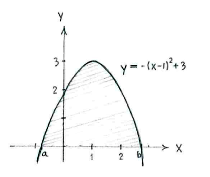Lösung 2.1:4b
Aus Online Mathematik Brückenkurs 2
By completing the square of the equation of the curve
\displaystyle \begin{align}
& y=-x^{2}+2x+2=-\left( x^{2}-2x-2 \right) \\
& =-\left( \left( x-1 \right)^{2}-1^{2}-2 \right)=-\left( x-1 \right)^{2}+3 \\
\end{align}
we can read off that the curve is a downward parabola with maximum value
\displaystyle y=\text{3 }
when
\displaystyle x=\text{1}
The region whose area we shall determine is the one shaded in the figure.
We can express this area using the integral
Area= \displaystyle \int\limits_{a}^{b}{\left( -x^{2}+2x+2 \right)}\,dx
where \displaystyle a and \displaystyle b are the \displaystyle x -coordinates for the points of intersection between the parabola and the \displaystyle x -axis.
A solution plan is to first determine the intersection points, \displaystyle x=a and \displaystyle x=b, and then calculate the area using the integral formula above.
The parabola cuts the \displaystyle x -axis when its \displaystyle y -coordinate is zero, i.e.
\displaystyle 0=-x^{2}+2x+2
and because we have already completed the square of the right-hand side once, the equation can be written as
\displaystyle 0=-\left( x-1 \right)^{2}+3
or
\displaystyle \left( x-1 \right)^{2}=3.
Taking the root gives \displaystyle x=1\pm \sqrt{3}. The points of intersection \displaystyle x=1-\sqrt{3} and \displaystyle x=1+\sqrt{3}.
The area we are looking for is therefore given by
Area \displaystyle =\int\limits_{1-\sqrt{3}}^{1+\sqrt{3}}{\left( -x^{2}+2x+2 \right)}\,dx
Instead of directly starting to calculate, we can start from the integrand in the form we obtain after completing its square,
Area= \displaystyle =\int\limits_{1-\sqrt{3}}^{1+\sqrt{3}}{\left( -\left( x-1 \right)^{2}+3 \right)}\,dx
which seems easier. Because the expression
\displaystyle x-1
inside the square is a linear expression, we can write down a primitive function “in the usual way”,
Area \displaystyle =\left[ -\frac{\left( x-1 \right)^{3}}{3}+3x \right]_{1-\sqrt{3}}^{1+\sqrt{3}}
(If one is uncertain of this step, it is possible to differentiate the primitive function and see that one really does get the integral back). Hence,
\displaystyle \begin{align}
& \text{Area}=-\frac{\left( 1+\sqrt{3}-1 \right)^{3}}{3}+3\left( 1+\sqrt{3} \right)-\left( -\frac{\left( 1-\sqrt{3}-1 \right)^{3}}{3}+3\left( 1-\sqrt{3} \right) \right) \\
& =-\frac{\left( \sqrt{3} \right)^{3}}{3}+3+3\sqrt{3}+\frac{\left( -\sqrt{3} \right)^{3}}{3}-3+3\sqrt{3} \\
& =-\frac{\sqrt{3}\sqrt{3}\sqrt{3}}{3}+3\sqrt{3}+\frac{\left( -\sqrt{3} \right)\left( -\sqrt{3} \right)\left( -\sqrt{3} \right)}{3}+3\sqrt{3} \\
& =-\frac{3\sqrt{3}}{3}+3\sqrt{3}-\frac{3\sqrt{3}}{3}+3\sqrt{3} \\
& =-\sqrt{3}+3\sqrt{3}-\sqrt{3}+3\sqrt{3} \\
& =\left( -1+3-1+3 \right)\sqrt{3}=4\sqrt{3} \\
\end{align}
NOTE: The calculations become a lot more complicated if one starts from
\displaystyle =\int\limits_{1-\sqrt{3}}^{1+\sqrt{3}}{\left( -x^{2}+2x+2 \right)}\,dx=....

